 |
 |
 |
| |
Telbivudine GLOBE Trial at Year Two: Efficacy, Safety, and Predictors of Outcome in Patients with Chronic Hepatitis B
|
| |
| |
Reported by Jules Levin
DDW, May 19-24, 2007, Washington DC
S.H. Han1; C.L. Lai2; E. Gane3; Y.F. Liaw4; S. Thongsawat5; Y. Wang6; Y. Chen7; J. Heathcote8; J. Rasenack9; N. Bzowej10; N. Naoumov11; N. Brown12; and the GLOBE Study Group
1UCLA School of Medicine, Los Angeles, CA, USA; 2University of Hong Kong, Hong Kong, China; 3Middlemore Hospital, Auckland, NZ; 4Chang Gung University and Memorial Hospital, Taipei, Taiwan; 5Chiang Mai University, Chiang Mai, Thailand; 6Southwest Hospital, Chongqing, China; 7Zhejiang University College of Medicine, Hangzhou, China; 8Toronto Western Hospital, Toronto, ON, Canada; 9Albert Ludwigs Universit_t, Freiburg, Germany; 10Sutter Health, San Francisco, CA, USA; 11University College, London, UK; 12Idenix Pharmaceuticals, Cambridge, MA, USA.
Summary:
The randomized ITT population included 1367 patients; 921 HBeAg-positive and 446 HBeAg-negative. HBV DNA at baseline was a median 9.6 log in HBeAg+ and 7.6 log in HBeAg-negatives. In HBeAg+ mean HBV DNA declined by 5.7 log for telbivudine vs 4.4 for lamivudine. In patients with baseline ALT 2 or more times greater than ULN, HBV DNA declined by 6.05 log for telbivudine and 5.04 for lamivudine. 56% achieved <300 copies/ml taking telbivudine vs 39% for lamivudine. If baseline ALT was >2 x ULN this increased to 61% & 43%, respectively. ALT normalization to <1 x ULN was 70% for telbivudine & 62% for lamivudine. HBeAg loss was 36% vs 29%. HBeAg seroconversion 30% vs 25%. In all cases the percentages were a little higher for patients with baseline ALT >2 x ULN. Cumulative drug resistance in HBeAg-positives after 92 weeks of therapy was 17.8% for patients taking telbivudine and 30% for patients taking lamivudine. In HBeAg-negative patients cumulative drug resistance was 7.3% for telbivudine and 16.6% for lamivudine. Grade 3-4 lab abnormality of creatine kinase >/= 7.0 x ULN was 12.9% for telbivudine and 4.1% for lamivudine.
Author Conclusions:
Telbivudine exhibited significantly greater antiviral and clinical efficacy, with less resistance, than lamivudine after 2 years of treatment.
In HBeAg-positive patients with baseline ALT >2 x ULN, generally considered the best treatment candidates, a significantly higher rate of seroconversion was observed with telbivudine than with lamivudine.
The post-treatment durability of HBeAg loss or seroconversion was >80% with telbivudine and lamivudine.
Patients achieving the best early viral suppression, assessed as serum HBV DNA levels at week 24, had the highest rates of efficacy response and the least resistance at week 104.
Any persistent, unexplained muscle-related symptoms with telbivudine should be evaluated promptly. Patients with myopathy (confirmed muscle weakness) should have telbivudine discontinued permanently..
Background
Telbivudine, an L-nucleoside with potent and specific activity against the hepatitis B virus (HBV), is widely approved for the treatment of compensated chronic hepatitis B (CHB).1 A large, 2-year, international randomized clinical trial (GLOBE) compared the safety and efficacy of telbivudine and lamivudine in 1367 nucleos(t)ide-naive patients with hepatitis B e antigen (HBeAg)-positive or HBeAg-negative CHB. The GLOBE trial is the largest hepatitis B drug registration trial to date. After 1 year, telbivudine showed significantly greater efficacy vs lamivudine on all direct measures of antiviral efficacy in both HBeAg-positive and HBeAg-negative patients.2 A quantitative association between serum HBV DNA reduction in the first 6 months of treatment and subsequent efficacy outcomes was also established.3 Here we report preliminary efficacy results from GLOBE after 2 years of treatment, including an analysis of relationships between serum HBV DNA levels at week 24 and efficacy outcomes at week 104.
Study Design
Eligible male and female patients were aged 16 to 70 years and had serum HBV DNA >6 log10 copies/mL, serum alanine aminotransferase (ALT) 1.3-10 times the upper limit of normal (ULN), positive serum HBsAg, and compensated liver disease. Patients were randomized 1:1 to treatment with telbivudine (600 mg/day PO) or lamivudine (100 mg/day PO) (Figure 1). Treatment assignments were stratified by baseline HBeAg status (positive or negative) and baseline ALT levels (≦ or ≥ 2.5 x ULN).
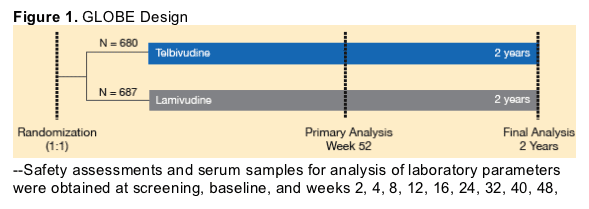
--Serum HBV DNA was quantified by COBAS Amplicor HBV Monitor assay (Roche Molecular Systems, Branchburg, NJ; lower limit of detection 300 copies/mL).
Study Endpoints
Efficacy
Therapeutic Response (primary efficacy endpoint):
Serum HBV DNA ≦105 copies/mL, and either ALT normalization or HBeAg loss
HBV DNA response:
_ Mean/median reduction from baseline
_ Clearance of PCR-detectable HBV DNA (<300 copies/mL)
- ALT normalization
- HBeAg loss and seroconversion (HBeAg-positive patients only)
- Liver histology (evaluated only at week 52)
Safety
Study discontinuations for any reason, and discontinuations for clinical or laboratory-determined adverse events.
Analyses of adverse events, serious adverse events, and graded laboratory abnormalities at each study visit up to week 104.
Resistance
Confirmed rebound of serum HBV DNA by ≥1 log10 copies/mL above nadir, after initial reduction of ≥1 log.4
Return of HBV DNA to >5 log, or within 1 log of baseline (per protocol).
Resistance at week 92:
_ Viral breakthrough with documented treatment-emergent resistance mutations, identified by PCR amplification of serum HBV DNA from patients with viral breakthrough, followed by automated DNA sequencing of the entire 344-codon reverse transcriptase domain of the HBV polymerase. Here we report a preliminary analysis of resistance at week 92.
Predictors of response
Efficacy and resistance outcomes after 2 years were assessed according to serum HBV DNA levels at 24 weeks: PCR-negative (<300 copies/mL); PCR detectable but <3 log10 copies/mL; 3-4 log10 copies/mL; and >4 log10 copies/mL.
Stepwise logistic regression analyses were performed to identify baseline and on-treatment parameters influencing outcomes at 2 years.
- On-treatment factors included serum HBV DNA and ALT levels at week 24
_ Baseline factors included age, ethnicity, geographic region, HBV genotype,
HBV DNA level, ALT level, Knodell HAI score, cirrhosis, BMI, weight, years since diagnosis, probable source of infection, previous interferon use, and treatment group
Statistical Analysis
All 1367 patients who started the GLOBE study and received ≥1 dose of drug were included in intent-to-treat (ITT) analyses of efficacy and safety at 2 years, including patients who discontinued for any reason.
Missing data = failure for categorical endpoints.
Categorical endpoint responses are reported only if maintained through week 104.5 Patients must have at least two consecutive qualifying values, and value at last visit must qualify.
A prospectively defined analysis identified a statistical interaction between HBeAg status and treatment effect for the primary and key secondary endpoints at 1 year. Therefore, results were analyzed separately for the HBeAg-positive and HBeAg-negative populations.
Results
Patients
The randomized ITT population included 1367 patients; 921 HBeAg-positive and 446 HBeAg-negative. Treatment groups were well matched with respect to demographic and disease parameters at baseline (Table 1).
Table 1. Baseline Demographics and Disease Characteristics6,7
46% to 58% of patients are Asian (Chinese); 11-25% Caucasian. Median log10 HBV DNA: 7.2 log in HBeAg-negatives and 9.6 log in HBeAg-positives. Median ALT 99 in HBeAG-negatives and 111 in HBeAg-positives.
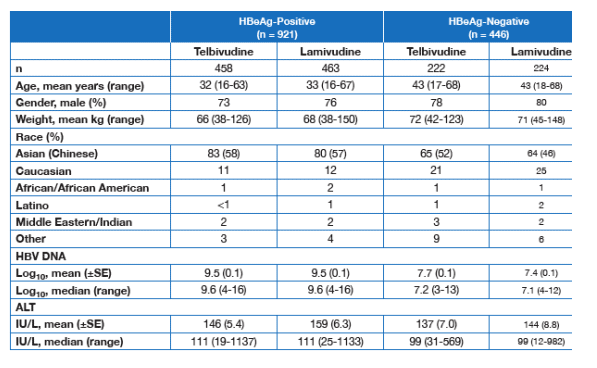
Efficacy Results in HBeAg-positive Patients
At year 2, significantly more HBeAg-positive telbivudine recipients achieved Therapeutic Response and ALT normalization, and had PCR-negative HBV DNA, compared to lamivudine recipients. Telbivudine recipients also demonstrated significantly greater log10 reduction of serum HBV DNA levels (Table 2).
Higher rates of HBeAg loss and seroconversion were also observed with telbivudine vs lamivudine, however these differences did not reach statistical significance in the overall HBeAg-positive population. From year 1 to year 2, rates of HBeAg loss for telbivudine increased from 26% to 35%, respectively, while rates of HBeAg seroconversion increased from 23% to 30%.
Among the 64% of HBeAg-positive patients with baseline ALT ≥2 x ULN, generally considered the best treatment candidates, telbivudine recipients demonstrated significantly higher rates of HBeAg loss and seroconversion after 2 years compared with lamivudine recipients (Table 2).7-9 Telbivudine also demonstrated significantly greater responses vs lamivudine for all other key efficacy endpoints in this subgroup.
Table 2. Efficacy at Week 104 in HBeAg-positive Patients6,7
HBV DNA reduced by 5.7 log with Telbivudine vs -4.4 for LAM (p <0.0001).
PCR NEGATIVE (<300 copies/ml): 56% Telbivudine, 39% LAM (<0.0001).
ALT Normalization (
HBeAg Loss: 35% Telbivudine, 29% LAM (0.056)
HBeAg Seroconversion: 30% Telbivudine, 25% LAM (0.095)
If Baseline ALT >/=2 x ULN:
HBV DNA reduced by 6.05 log with Telbivudine, -5.04 log with LAM (<0.001)
PCR Negative (<300 c/ml): 61% Telbivudine, 43% (<0.001)
ALT Normalization: 72% Telbivudine, 63% LAM (0.024)
HGeAg Loss: 41% Telbivudine, 32% LAM (0.021)
HBeAg Seroconversion: 36% Telbivudine, 27% LAM (0.022)
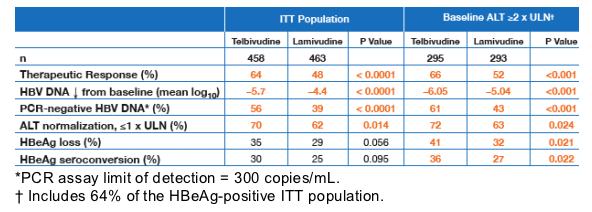
HBeAg-positive patients were eligible for treatment discontinuation for efficacy provided they had (1) received ≥1 year of treatment; (2) serum HBV DNA <5 log10 copies/mL; and (3) received ≥24 weeks of further treatment after initial detection of HBeAg loss. Discontinued patients received post-treatment follow-up with normal per protocol scheduled study visits.10
- Treatment was restarted upon posttreatment disease relapse (increase of serum HBV DNA to levels ≥ 6 log10 copies/mL on ≥2 consecutive visits AND ALT levels ≥2 x ULN)
Among HBeAg-positive patients discontinued for efficacy, HBeAg responses were sustained in ≥80% of patients in both treatment groups, following a median 31 weeks off-treatment (Table 3).

134/458 (29%) of patients receiving telbivudine, and 123/463 (27%) of patients receiving lamivudine, were eligible for treatment discontinuation. 59/257 (23%) patients were discontinued at the discretion of the investigator.
Includes patients with at least one post-treatment follow-up visit
Efficacy results in HBeAg-negative patients
HBeAg-negative telbivudine recipients demonstrated significantly greater log10 reduction of serum HBV DNA, and significantly greater rates of Therapeutic Response and PCR-negative HBV DNA at week 104 compared with lamivudine recipients (Table 4). ALT normalization was more frequent with telbivudine vs lamivudine; however, this difference was not statistically significant.6

Resistance and Treatment Failure
In a preliminary analysis of M204 codon changes at week 92, cumulative resistance rates were significantly lower with telbivudine vs lamivudine, in HBeAg-positive and in HBeAg-negative patients (Table 5).
Table 5. Preliminary Cumulative Resistance Analysis at Year 2 (92 weeks)
17.8% cumulative resistance with Telbivudine, 30.1% with LAM in HBeAg positives; in HBeAg negatives 7.3% cumulative resistance with Telbivudine, 16.6% with LAM (per procol). 1 log above nadir: 21.6% with Telbivudine, 35% with LAM (HBeAg-positive); 8.6% with Telbivudine, 21.9% with LAM in HBeAg negative.

Association Between Early Viral Suppression and Outcomes at 2 Years
At week 24, a greater proportion of telbivudine recipients were serum HBV DNA PCR-negative, compared with lamivudine (Figure 2).
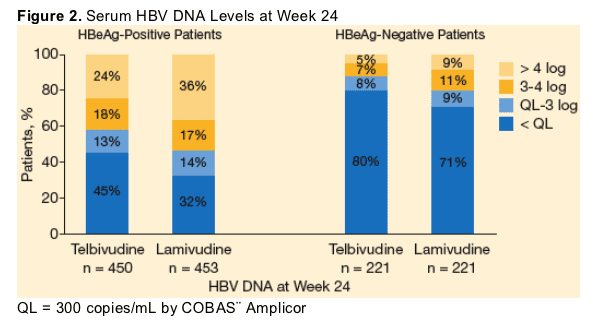
Patients who achieved the best early viral suppression (PCR-negative HBV DNA at week 24) had the highest rates of efficacy response and the lowest rates of resistance at year 2 (92 weeks).
Serum HBV DNA levels at week 24 were inversely correlated with efficacy outcomes at week 104, extending results reported previously at week 52.3 These relationships were evident for all efficacy responses evaluated at week 104, including HBeAg loss, ALT normalization, and PCR-negative HBV DNA (Figure 3a-c).11
A direct relationship was observed between HBV DNA levels at week 24 and subsequent resistance (based upon a per protocol preliminary resistance analysis at week 92) (Figures 3d). Of telbivudine recipients who had PCR-negative HBV DNA at week 24, only 4% of HBeAg-positive patients and 2% of HBeAg-negative patients developed resistance at week 92.
Similar relationships between week 24 HBV DNA levels and outcomes at 2 years were observed for telbivudine and lamivudine; however, HBV DNA was PCR-negative in a significantly greater proportion of telbivudine recipients at week 24 (Figure 2). This suggests that the overall higher rates of efficacy response and lower resistance seen with telbivudine at 2 years (Table 2 and Table 4) are associated with the greater early viral suppression achieved with telbivudine.
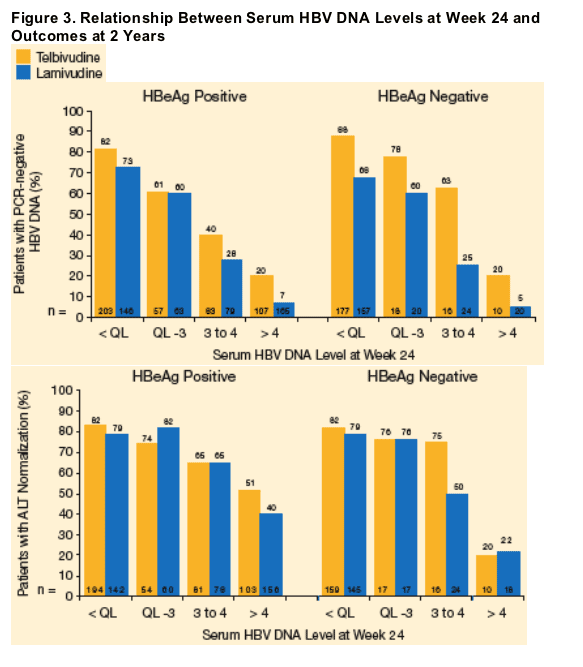
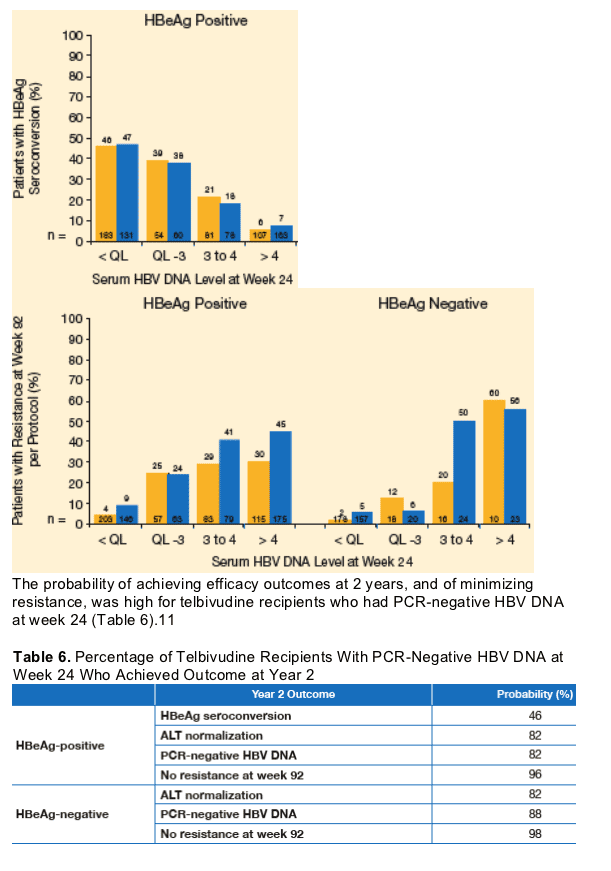
Predictors of Response
Stepwise linear regression analyses were undertaken to identify baseline and on treatment parameters that influence treatment outcomes. Results indicate that serum HBV DNA level at week 24 was the strongest predictor of HBeAg seroconversion, PCR nondetectability, and ALT normalization at 2 years. Factors with statistically significant odds ratios are shown in Figure 4.
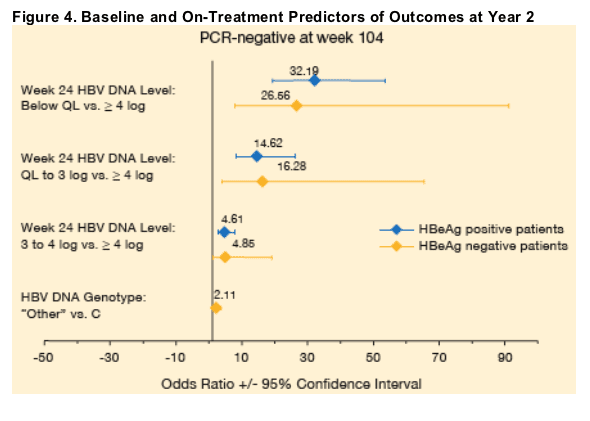
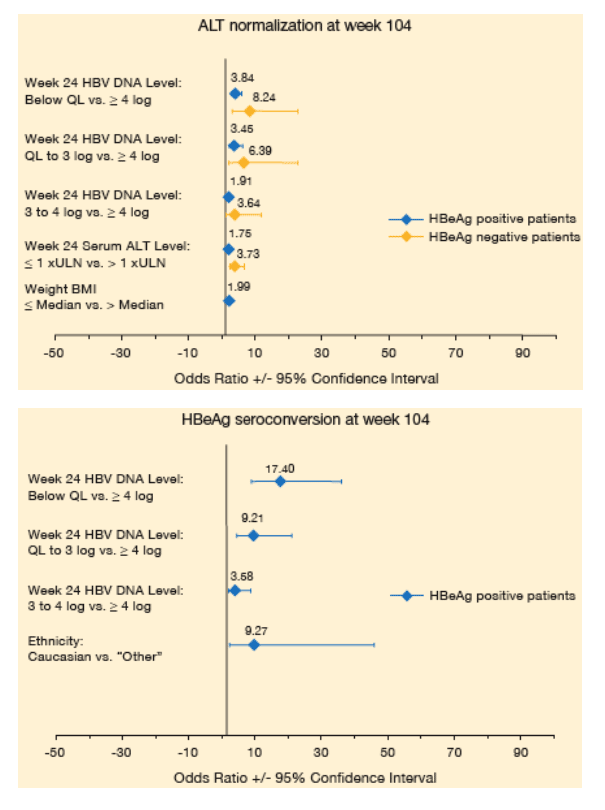
Safety Through Week 104
Most adverse events were classified as mild or moderate in severity and not attributed to telbivudine.
56 (8.2%) telbivudine recipients and 88 (12.8%) lamivudine recipients discontinued. Discontinuations for adverse events, clinical disease progression or lack of efficacy were 11 (1.6%) for telbivudine and 28 (4.1%) for lamivudine.
Grade 3-4 creatine kinase (CK) elevations were more frequent among telbivudine recipients (12.9%) vs. lamivudine (4.1%). Most CK elevations were asymptomatic, but the mean recovery time was longer for subjects on telbivudine vs.
lamivudine.
On-treatment ALT flares using AASLD criteria (> 10.0 x ULN and 2.0 x baseline1) were more frequent with lamivudine (7.4%) vs. telbivudine (4.1%).
Cases of myopathy were reported with telbivudine use several weeks to months after starting therapy.
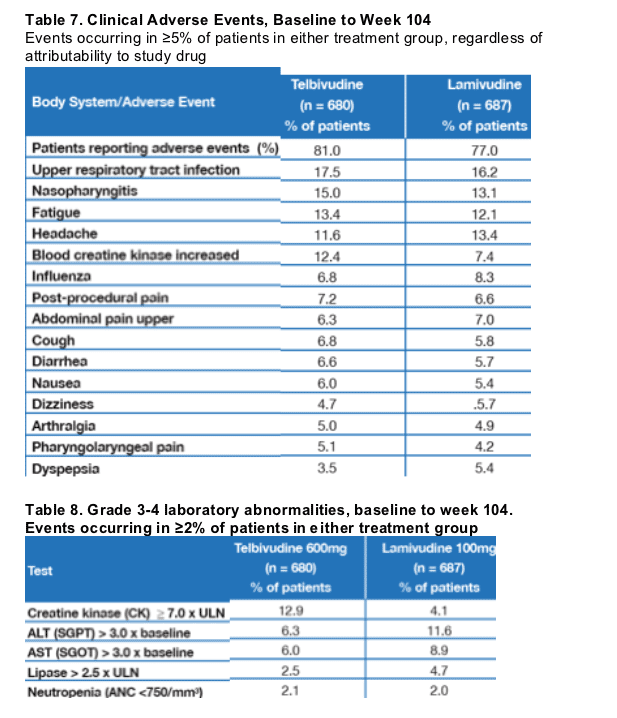
REFERENCES
1. Standring DN, Bridges EG, Placidi L, et al. Antiviral _-L-nucleosides specific for the hepatitis B virus infection. Antivir Chem Chemother. 2001;12(suppl 1):119-129.
2. Lai CL, Gane E, Liaw YF, et al. Telbivudine (LdT) vs. lamivudine for chronic hepatitis B: first-year results from the international phase III GLOBE trial [Abstract]. Hepatology 2005;42(4 suppl. 1):748A.
3. Lai CL, Gane E, Liaw YF, et al. Maximal early HBV suppression is predictive of optimal virologic and clinical efficacy in nucleoside-treated hepatitis B patients: scientific observations from a large multinational trial (the GLOBE study) [Abstract]. Hepatology 2005;42(4 suppl. 1):232A-233A.
4. Locarnini S, Hatzakis A, Heathcote J, et al. Management of antiviral resistance in patients with chronic hepatitis B. Antiviral Ther. 2004;9:679-693.
5. Lok AS, Heathcote EJ, Hoofnagle J, et al. Management of hepatitis B: 2000- summary of a workshop. Gastroenterology. 2001;120:1828-1853.
6. Lai CL, Gane E, Liaw YF, et al. Two-year results from the GLOBE trial in patients with hepatitis B: greater clinical and antiviral efficacy for telbivudine (LdT) vs. lamivudine. Hepatology. 2006;44(4 suppl 1):222A.
7. Rasenack J, Poynard T, Lai CL, et al. Efficacy of telbivudine vs lamivudine at 2 years in patients with HBeAg-positive chronic hepatitis B who are eligible for treatment based on guidelines. J Hepatol. 2007;46(suppl 1):S195.
8. Liaw YF, Leung N, Guan R, et al. Asian-Pacific consensus statement on the management of chronic hepatitis B: a 2005 update. Liver Int. 2005;25:472-489.
9. Lok AS, McMahon BJ. Chronic hepatitis B. Hepatology.2007;45:507-539.
10. Poynard T, Chutaputti A, Dyu S, et al. Sustained off-treatment HBeAg response in telbivudine and lamivudine treated HBeAg-positive patients from the GLOBE study. J Hepatol. 2007;46(suppl 1):S27.
11. Di Bisceglie AM, Lai CL, Gane E, et al. Telbivudine GLOBE trial: maximal early HBV suppression is predictive of optimal two-year efficacy in nucleoside treated hepatitis B patients. Hepatology. 2006;44(4 suppl 1):230A.
12. Tyzeka [US package insert]. Idenix Pharmaceuticals; Novartis Pharmaceuticals; October 2006.
|
| |
|
 |
 |
|
|